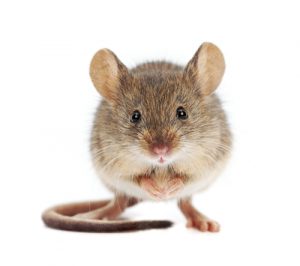Yes, Mice Gnaw Holes!
By Chris Williams on September 12, 2011.
Q. Do mice make semicircular holes in baseboards just like in the cartoons? There’s a small hole through the baseboard of our downstairs game room that looks kind of like it’s been chewed open into the wall space. And we have seen a mouse down there.
A. You bet mice gnaw openings, but usually not as neatly as in the cartoons! Mice are known for gnawing to keep their incisors worn down. But mice mostly gnaw in an attempt to gain entrance to an area that looks interesting for either a nest site or a source of food. If a mouse can find an edge or a corner that it can bite with its teeth, it can gnaw an opening big enough to get the rest of its body through. And a mouse doesn’t need a very big opening. A mouse can squeeze through a slot that is only 1/4 inch wide or a hole about the size of a dime.
 You can tell how recent the gnawing on wood is by the color; fresh gnaws are lighter in color and older gnawing is darker. As mice go back and forth through an opening, they also leave dark, greasy rub marks from the oils in their fur on the edges of the opening.
You can tell how recent the gnawing on wood is by the color; fresh gnaws are lighter in color and older gnawing is darker. As mice go back and forth through an opening, they also leave dark, greasy rub marks from the oils in their fur on the edges of the opening.
A mouse can chew on just about any material that is softer than its teeth. It can easily chew through plasterboard, wood, vinyl siding, and fiberboard. Mice often gnaw on electrical wires and have been known to cause fires. They’re not picky about what they gnaw on and can damage books, paintings, clothing and heirlooms that are stored in attics and closets.
Your mouse (and its extended family) may be living inside the wall void in your game room. Usually mice nest within 10-30 feet of their primary food source, but that can be 10-30 feet up, down, or sideways. If your kitchen is the mouse’s food source, then the mice may be traveling upwards through the walls to get to that food. If you feed pets or store pet food or bird seed downstairs, that could be the primary food source for the mice instead. If you were able to access that mousey space behind the baseboard, you might find mouse nest material (shredded paper, insulation, fabric, string, etc.) and even stolen food that has been stored there.
You can caulk that mouse hole or stuff it with steel wool but you risk sealing the mice into the wall void. They will either chew a new way out or will die, resulting in an odor problem. It’s important to get rid of the mice first, and then either you or a pest control company should pestproof your home to keep mice out. Give Colonial a call today. Our trained technicians are experts at mouseproofing structures. They know how to find and seal all those little openings that let mice inside.